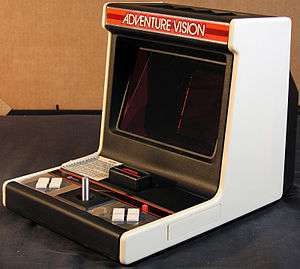Entex Adventure Vision
 | |
| Manufacturer | Entex Industries |
|---|---|
| Type | Video game console |
| Generation | Second generation |
| Release date | 1982 |
| Discontinued | 1983[1] |
| Units sold | 50,757[2] |
| Media | ROM cartridge |
| CPU | Intel 8048 @ 733 kHz |
| Predecessor | Entex Select-A-Game |
The Adventure Vision is a self-contained (no external monitor is required) cartridge-based video game console released by Entex Industries in 1982. The Adventure Vision was Entex's second generation system. Their first console was the Entex Select-A-Game, released a year earlier in 1981.
Background
Control is through a single multi-position joystick and two sets of four buttons, one on each side of the joystick, for ease of play by both left- and right-handed players.
Rather than using an LCD screen or an external television set like other systems of the time, the Adventure Vision uses a single vertical line of 40 red LEDs combined with a spinning mirror inside the casing. This allows for a screen resolution of 150 × 40 pixels. Another product using this technique was produced by Nintendo in the mid 1990s–the Virtual Boy.
The game cartridges can be stored in spaces on top of the case.
Drawbacks to the Adventure Vision are its monochrome (red) screen as well as the mirror motor, which draws a great deal of power from the batteries. The latter problem can be avoided by the use of the built-in AC adapter port.
Entex released four games for the Adventure Vision:
- Defender, based on the Williams Electronics arcade game of the same name
- Super Cobra, based on the Konami arcade game of the same name
- Turtles, based on the Konami arcade game of the same name (similar to Pac-Man)
- Space Force, based on the Venture Line arcade game of the same name (similar to Asteroids)
On March 31, 2013 at the Revision demoparty, the first ever homebrew/demo ROM for the system was demonstrated[3] by MEGA - Museum of Electronic Games & Art. MEGA also released[4] the source code for the demo as well as all development tools.
Technical specifications
- CPU: Intel 8048 @ 733 kHz
- Sound: National Semiconductor COP411L @ 52.6 kHz
- RAM: 64 bytes (internal to 8048), 1K (on main PCB)
- ROM: 1K (internal to 8048), 512 bytes (internal to COP411L), 4K (cartridge)
- Input: 4 direction joystick, 4 buttons duplicated on each side of the joystick
- Graphics: 150x40 monochrome pixels
Emulation
The system is supported by the MESS emulator and by the specialized AdViEmulator.[5]
References
- ↑ Forster, Winnie (2005). The encyclopedia of consoles, handhelds & home computers 1972 - 2005. GAMEPLAN. p. 53. ISBN 3-00-015359-4.
- ↑ Forster, Winnie (2005). The encyclopedia of consoles, handhelds & home computers 1972 - 2005. GAMEPLAN. p. 53. ISBN 3-00-015359-4.
- ↑ Revision 2013 demoparty entry on pouet.net
- ↑ Open Source Adventure Vision development kit including demo source code
- ↑ AdViEmulator, a specialized Open Source Adventure Vision emulator